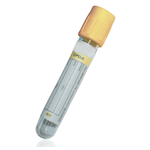Suitable Specimen Types
- Serum
- Li Hep Plasma
Sample Processing in Laboratory
Usual
Sample Preparation
Centrifuge and carry out assay as soon as possible
Turnaround Time
1 daySample Stability
Serum or heparinised plasma are suitable.
Samples should be protected from light prior to assay. Samples are stable for 7 days when stored at 4˚C or 6 months when stored at -20˚C, however they must me entirely protected from light
Bilirubin (Direct)
General Information
Bilirubin metabolism begins with the breakdown of red blood cells by phagocytic cells. Red blood cells contain hemoglobin, which is broken down to heme and globin. Heme is converted to bilirubin, which is then carried by albumin in the blood to the liver. In the liver, most of the bilirubin is conjugated (chemically attached to) with a glucuronide before it is excreted in the bile.
Measurement of direct bilirubin gives an estimate of the conjugated bilirubin. Unconjugated bilirubin is also known as indirect bilirubin. Total serum bilirubin equals direct bilirubin plus indirect bilirubin.
Conjugated bilirubin is excreted into the bile by the liver and stored in the gall bladder or transferred directly to the small intestines. Bilirubin is further metabolized by bacteria in the intestines to urobilins, which contribute to the color of the feces. A small percentage of these compounds are reabsorbed and eventually appear in the urine, where they are referred to as urobilinogen.
The test is useful in the evaluation of liver and biliary disease. Increased direct bilirubin occurs with biliary diseases, including both intrahepatic and extrahepatic lesions. Hepatocellular causes of elevation include hepatitis, cirrhosis, and advanced neoplastic states. Increased with cholestatic drug reactions, Dubin-Johnson syndrome, and Rotor syndrome.
Theoretically, direct bilirubin should not be increased in hemolytic anemias, in which bilirubin increase should be in the indirect bilirubin fraction in the absence of complications. In practice, some increase in the direct fraction may be encountered in patients with hemolytic anemia in whom complications have not been proven. Some methods have shown the direct bilirubin to be spuriously high. This may be due to different concentrations of sodium nitrite, which may convert some of the unconjugated bilirubin to conjugated bilirubin. Direct bilirubin is the water soluble fraction. When increased in serum, bilirubin should become positive in the urine.
The measurement is important in children with jaundice as it can help identify those with liver disease requiring active intervention.(e.g. biliary atresia)
Patient Preparation
None
Notes
Haemolysis and lipaemia interference do not signicantly affect this assay.
Reference Range
0-5 µmol/L
(Source : Synermed Kit Insert)
Specifications
- EQA Scheme?: Yes
-
EQA Status:
NEQAS
